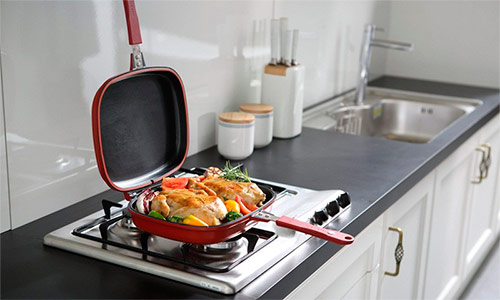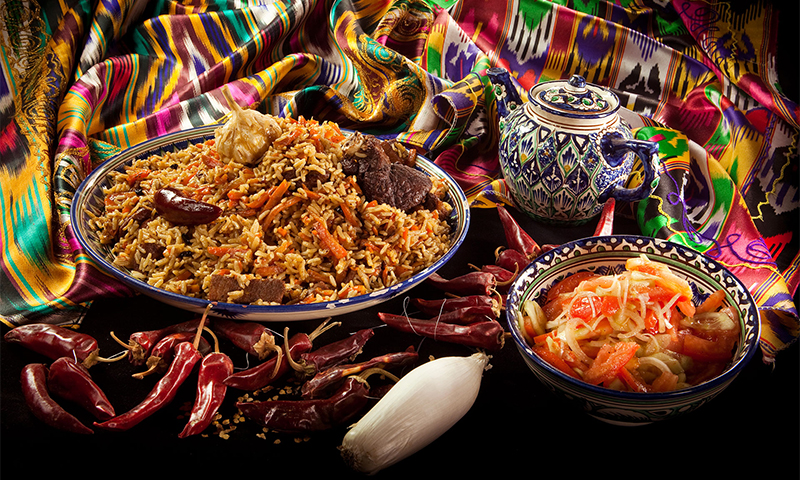A professional chef always has at least a dozen different pans of different shapes and sizes. In an ordinary kitchen, such an insane amount of utensils will not fit, and you don’t need that much. It is enough to choose 1-2 suitable models that can cope with everyday tasks: cooking zazharki, cutlets or scrambled eggs. And for special occasions, you can buy some exotic things like wok or grilled pans. Nevertheless, you also need to be able to choose kitchen utensils - so that she copes well with her duties and does not give the hostess any extra trouble.
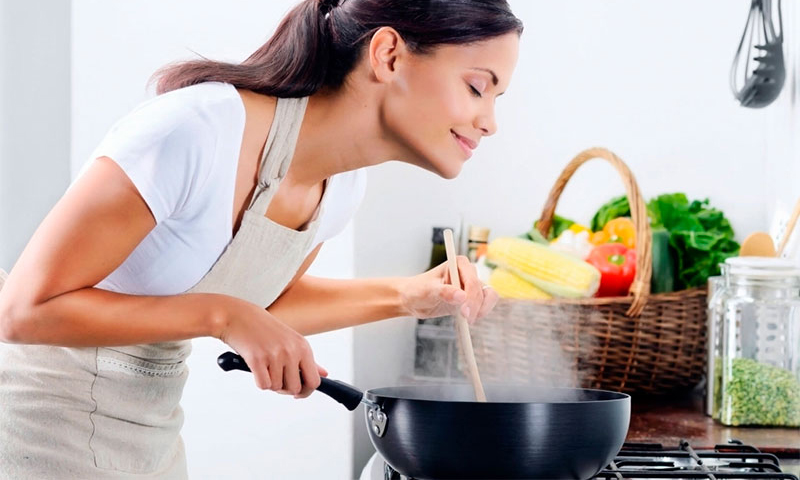
Content:
The best manufacturers of pans - which company to choose
To narrow the circle of searches, for a start we will decide which brands of pans should be considered at all. After all, the quality, safety and service life of your dishes depends on it.
The best frying pans in all three parameters are produced by well-known companies:
- Tefal;
- Rondell;
- Fissler;
- Gipfel;
- Risoli.
We have already considered models of these and other worthy manufacturers in ranking best pans. Now let's understand what kind of utensils you need to choose for your kitchen, in order to limit ourselves to a minimum, but a full set of pans “for all occasions”.
Types of pans
Classic
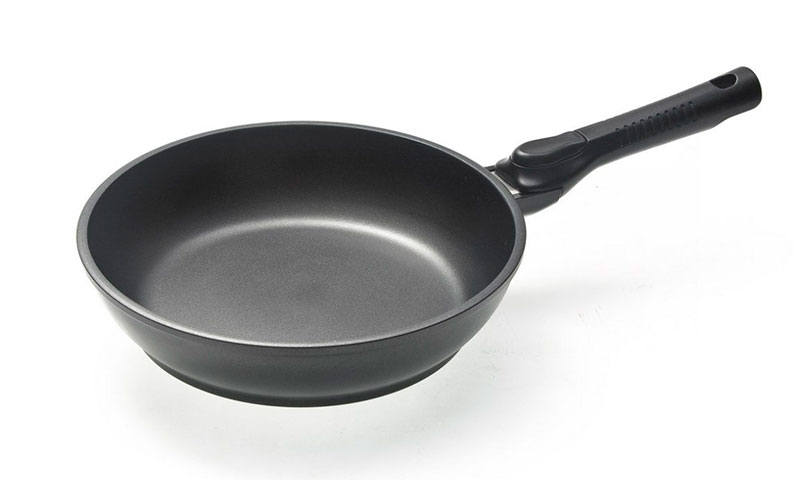
The most versatile model that is suitable for cooking most dishes: frying, steaming, stewing, etc. In 90% of cases, it has a round shape and 1-2 knobs. Sometimes a spout is formed on the side to make it easier to drain the melted fat.
Pros:
- Always a large selection of models and sizes;
- Universality;
- Long service life;
- Ease of care;
- Easy to find a suitable cover;
- Low cost.
Minuses:
- It is inconvenient to store on shelves and in boxes - a lot of unused space remains.
Grill

Frying pan with a ribbed bottom, in most cases has a square shape, but there are also round models. This utensil is designed exclusively for frying and has a rather big weight. Its embossed bottom allows you to cook without fat and leaves on the products characteristic fried strips, as if from a grill grate.
Pros:
- Products can be easily removed from the pan;
- Dishes are not saturated with fat and retain their natural flavor;
- The ribs do not create special difficulties when washing;
- You can save on oil;
- Creates a delicious grill effect on the surface of products.
Minuses:
- Suitable only for frying;
- Great weight.
Brazier

Deep frying pan, which is suitable for frying, roasting in the oven and stewing large portions of food for the whole family. It is made of cast iron or steel with a thickened multi-layer bottom, thanks to which it distributes heat evenly and prevents food from burning. A distinctive feature of any brazier is a pair of small cast handles on the sides.
Pros:
- Versatility - replaces the pot, utyatnitsa and baking dish;
- You can put in the oven;
- Large internal volume;
- Uniform cooking of dishes without burning.
Minuses:
- High price;
- Great weight;
- Heated and too small handles.
Stewpan
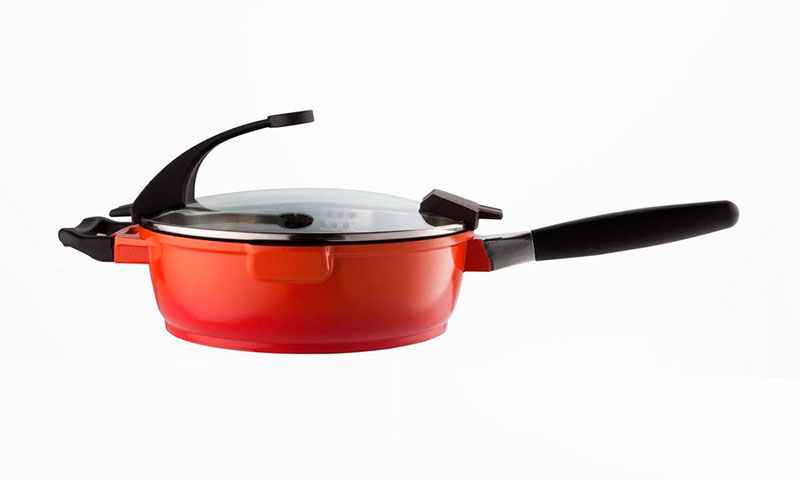
Hybrid pans, ladle and pots in which you can cook absolutely any dish: from sauces and scrambled eggs, ending with stews and soups. It has a round shape and a relatively large depth, and its walls and bottom are specially thickened, which ensures an even distribution of heat.
Any stewpot is necessarily equipped with a lid, since such dishes are designed to extinguish food, which means that moisture should remain in the dish as much as possible.Depending on the volume, the saucepan can have 1 or 2 handles - the second is placed on large containers that are difficult to hold with one hand.
Pros:
- Ideal for stewing and boiling;
- Products do not burn and evenly warm up;
- Compact size;
- Cover included.
Minuses:
- The cost is higher than other types of pans.
Wok

This deep conical pan came to us not so long ago from Asia, but has already won the hearts of buyers in the CIS.
The wok has a round shape with high sides, sharply expanding upwards. It has a narrow bottom (in the classic version is round, but there are also flat models), cast handles - made in the form of semicircular “ears”. Due to the design features, the wok warms up quickly and the dishes are easy to stir, but this will have to be done constantly.
Pros:
- Multifunctionality;
- Large capacity;
- High heating rate;
- Products are well saturated with spices and fat.
Minuses:
- It is necessary to mix the dish all the time;
- Takes a lot of space;
- A round bottom will require a special hotplate on the stove.
Crepe Maker

A shallow round pan, as the name implies, is intended for frying pancakes. But it is also suitable for cakes, pancakes, fritters and fried eggs. Differs in small weight and often goes with an antiprigarny covering.
Pros:
- Easy and comfortable;
- Thanks to non-stick coating, pancakes do not stick;
- Flat bottom - suitable for all types of plates.
Minuses:
- High cost for its reduced functionality.
Pan selection options
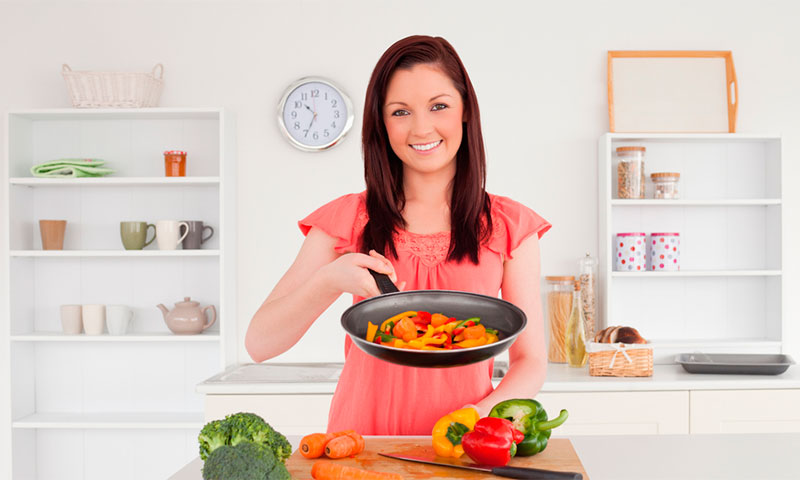
Manufacturing material
The material from which the pan is made is the main selection criterion. Service life, price, weight and features of care for kitchen utensils depend on it. For the production of the most commonly used: steel, cast iron, aluminum, copper and ceramics. Let's sort everything in order.
1. Cast iron pans are good old classics. Such models are the most reliable and practically unkillable, although the heavy weight of the utensils becomes the price paid for it. Cast iron is an excellent conductor and heat accumulator, and its thick walls calmly withstand high temperatures of up to +300 ° C. The only drawback of such pans - a tendency to corrosion.
2. Stainless steel pans are a good idea, but in most cases the performance is “lame”. Many manufacturers save on metal, and as a result, even for dishes with a good capsulated bottom, the walls are too thin. But such a utensil does not enter into chemical reactions with products, is resistant to scratches and corrosion, and food remains are easily removed from its smoothly polished surface.
3. Aluminum pans - quickly heated and cooled. However, here it is necessary to distinguish between cast and thin-walled models. The first in their characteristics are close to cast-iron ones: they serve as long, but they weigh a lot. Thin-walled dishes, on the contrary, can be deformed even during storage, but it is cheap and, moreover, it turns out to be the easiest and most convenient.
4. Copper ware today again returned to our kitchen. Pans from this metal are no exception. In them, the products do not lose their taste and are well roasted. The disadvantage of such pans is the possible oxidation of copper over time, but if you choose a model with a protective coating, there will be no problems.
5. Ceramic pans (not to be confused with a ceramic coating) appeared relatively recently. Such pans are environmentally friendly, can be heated to +450 ° С and are highly resistant to mechanical damage. Their only drawback is sensitivity to rapid temperature changes.
Coating
Covering the pan has two functions: it protects the base material from possible corrosion and prevents food from sticking to the walls of the dish.
For a long time, Teflon (Teflon) was considered the only non-stick coating. It is still used in the manufacture of aluminum and thin steel pans.Fluoroplast can withstand temperatures up to +200 ° C, is resistant to chemicals and alkalis, but is afraid of scratches.
Some firms develop their own types of spraying based on this material - more heat-resistant and durable. These include tech innovations like Fortom, Excalibur, ECO-NanoPlex. But all of them have one common minus: when damaged or excessively heated, the top layer of Teflon begins to release toxic substances.
The safety of the fluoroplastic spraying has not yet been proven, so manufacturers continue to look for more environmentally friendly materials that can replace it.
The most common coating options for kitchen utensils:
1. Ceramic - more often applied to aluminum pans, but also found on cast iron and steel. This coating is much stronger and safer than Teflon, but with a point impact it can crack and break off into pieces.
2. Enameled - has properties similar to ceramics, that is, it is afraid of blows, but not scratches. Relatively inexpensive, but it can not be called non-stick. Most suitable for stewpans and roaster with their thick walls.
3. Granite (stone, marble) - evenly distributes heat to the pan and holds it for a long time. Although this coating is scratch-sensitive, it is considered more durable compared to Teflon. And yet with such dishes it is better to use wooden shovels, and in no case do not clean it with a metal scraper.
4. Diamond is a relatively new type of non-stick coating with high mechanical strength and excellent thermal conductivity. Freely withstands heating to +320 ° C and is easily cleaned from any contamination. However, you will have to pay for the pleasure - such pans are expensive, and their weight is sensitive.
5. Titanium - environmentally friendly, reliable and durable coating (its service life reaches 25 years). It has non-stick properties, does not require frying oil, is resistant to mechanical damage and does not increase the weight of the pan. The only negative is the high cost.
Dimensions
The weight of the pan, the thickness of its walls and the bottom - these are the parameters that affect the convenience and duration of use of utensils. Also depends on them the stability of the dishes and the uniform heating of the food. For normal cooking, the thickness of even the cheapest pan at the base should be at least 4-6 mm.
The height of the walls is selected depending on the type and volume of dishes in your standard menu.
Here you have to focus on the composition of the family:
1. 18-20 cm - enough for one person or quickly warming up a portion of food;
2. 24 cm - the optimal size for couples;
3. 26 cm - suitable for a family of 3 people;
4. 28 cm and more - frying pans for large families and holidays when you are waiting for guests.
Design features
This is a matter of usability, so here you have to make your own decisions. And if the bottom shape (round, oval or square) does not play a decisive role, then pens should be given attention.
In the pans there are two types of handles:
1. Short "ears" - often cast, therefore, are considered the most durable. But if it is an auxiliary handle on a large frying pan, it can be simply riveted to the rim (which will somewhat reduce its reliability).
2. Long handles - can be removable, solid-cast or simply attached to the sides of the pan. They usually have insulating lining made of plastic, wood, ceramics or bakelite. If the pan is small, a removable or even bolted handle is allowed. For large and heavy utensils, this option is unacceptable.
Plate type
Pans should be selected and taking into account the characteristics of the cooking surface. For gas and electric furnaces with cast iron burners, "pancakes" will suit any utensils. But modern panels may be more capricious.
The glass ceramic surface requires the use of dishes with a slightly concave and thickened bottom. When heated, it will even out and will stand confidently on a smooth panel.For induction furnaces, pans with a multi-layer bottom are required at all, where a disk made of a ferromagnetic alloy is installed inside (this is what he heats up under the influence of EM induction).
Which pan to choose
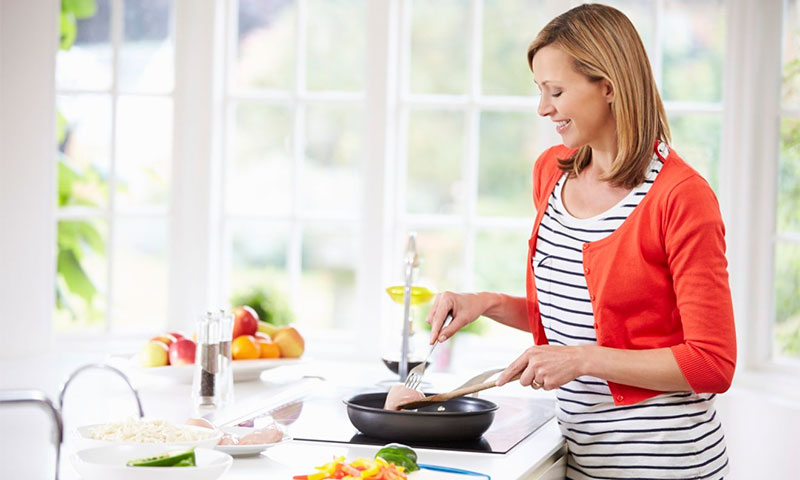
1. If you need an inexpensive and multifunctional griddle, then buy a classic cast-iron model. It is suitable for cooking almost all dishes, quite resistant to damage and will serve you until you get bored. Just look for dishes with a protective coating: enamels are enough outside, and inside, ceramics and granite will show themselves better.
2. Do you often fry meat or fish? Then you should buy a grill griddle to the basic kit. Take a model of cast iron or thick-walled steel, always with a cast handle and insulating lining on it. Pay attention to the presence of the spout - it will allow after cooking to carefully drain the gathered fat.
3. For those who cook stews, rice and roast on the stove or in the oven, a deep thick-walled ceramic, cast iron or cast aluminum brazier will do. Non-stick coating is not necessary here, but if you want aesthetics, you can do with enameling. Do you want to feed the family healthy foods with a minimum of fat? Then choose a roaster with a ceramic, titanium or granite coating.
4. In a small kitchen, where there is not enough space for numerous utensils, it is more convenient to use a saucepan. Due to its small diameter and optimum depth, it will easily fit even in a narrow locker. And still such universal dishes will make it possible to refuse to buy several additional pots, because in a saucepan you can not only fry and simmer, but also cook any dishes up to desserts, soups and cereals.
5. Fans of pancakes, fritters and quick breakfasts with scrambled eggs will suit a pancake pan. Choose a lighter model (aluminum or steel) with thin walls. But be sure to ensure that inside is a high-quality non-stick coating - even if Teflon.
How much does the pan

1. The simplest universal pans made of cast iron without coating cost from 400 to 1,500 rubles - these are mainly models of Russian and Chinese origin. Famous European brands produce dishes already coated on the outer sides and with an anti-corrosion coating, which affects the final cost of the utensils. Ceramics cost from 800 to 3000 rubles., Teflon 1.5-2 thousand, enameling from 1 to 14 thousand rubles.
2. Aluminum pans with diamond and titanium non-stick coating cost 2-17 thousand rubles, ceramic and marble coating come in the same price category - from 500 to 12 thousand rubles. Teflon and enamel cost the least - from 300 rubles to 6-7 thousand.
3. Utensils made of stainless steel, depending on the size and manufacturer, will cost from 900 to 18,000 rubles. Copper pans are the most expensive - their cost varies between 3-50 thousand rubles.
4. The price of grill pans starts from 700-800 rubles for ordinary cast iron and reaches 17 thousand for European cast models with elegant enameling and a square cover in the kit. Cast iron braziers depending on the volume will cost in the range of 800-12000 rubles.
5. The stew-pans start at half a thousand and easily reach the ceiling of 76,000 rubles, if this is a product of copper. For wok will have to pay from 800 to 20,000 rubles. The crepe makers also have a large run-up in prices: they can cost 400 rubles and 14 thousand - if they are branded dishes with a diamond coating.
It will be interesting to friends too



